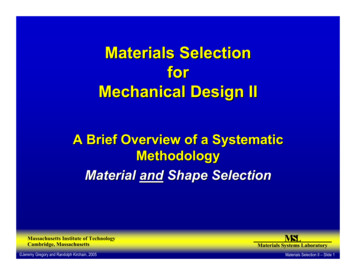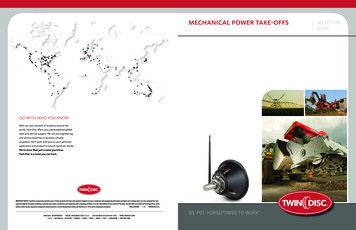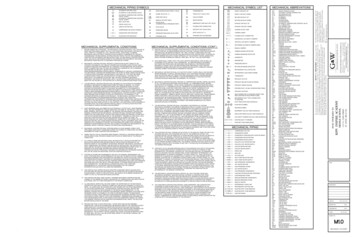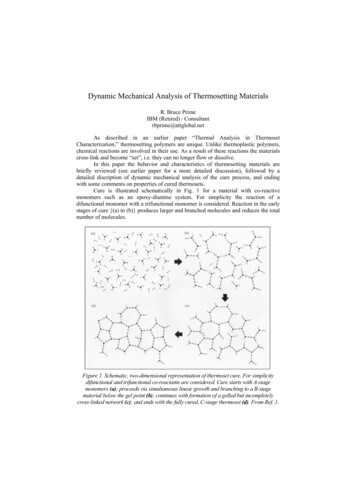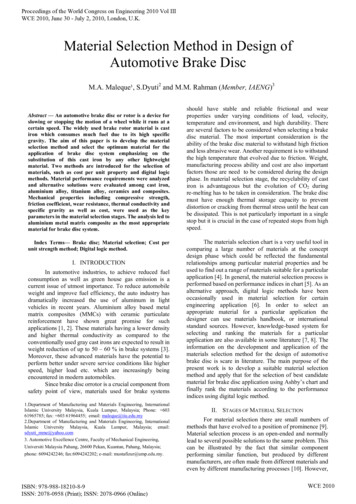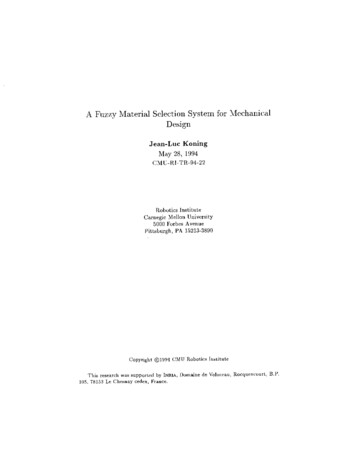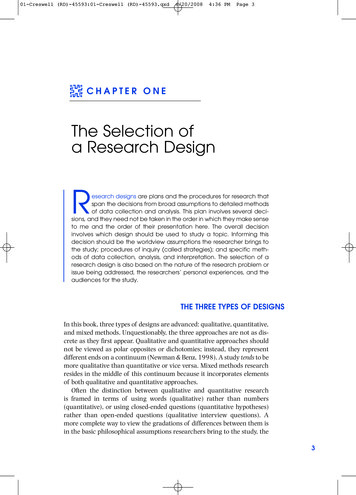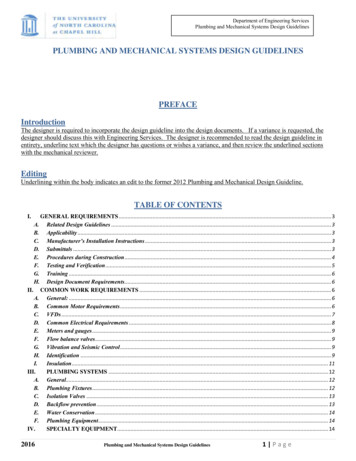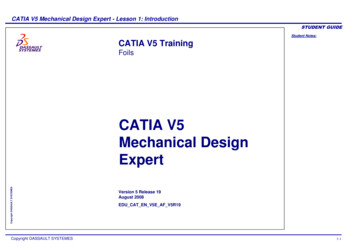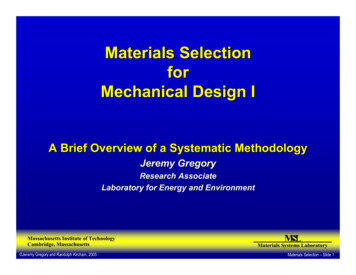
Transcription
Materials SelectionforMechanical Design IA Brief Overview of a Systematic MethodologyJeremy GregoryResearch AssociateLaboratory for Energy and EnvironmentMassachusetts Institute of TechnologyCambridge, Massachusetts Jeremy Gregory and Randolph Kirchain, 2005Materials Systems LaboratoryMaterials Selection – Slide 1
Relationship To Course A key concept throughout this course ishow to select among technology choices Economic AnalysisCost ModelingLife Cycle AssessmentFocus has been on economic assessmentof alternativesHow does this fit into larger technologychoice problem?Massachusetts Institute of TechnologyCambridge, Massachusetts Jeremy Gregory and Randolph Kirchain, 2005Materials Systems LaboratoryMaterials Selection I – Slide 2
Approach Changes as Design EvolvesMarket needLCADetailMethodNeeded forEarly StageCost ModelingDesign DetailEmbodiment# of CandidatesConceptEconomic AnalysisSelection MethodsProduction etc.Massachusetts Institute of TechnologyCambridge, Massachusetts Jeremy Gregory and Randolph Kirchain, 2005Materials Systems LaboratoryMaterials Selection I – Slide 3
What parameters define material selection?Example: SUV LiftgateImage removed for copyright reasons.Schematic of components in an SUV liftgate (rear door).Massachusetts Institute of TechnologyCambridge, Massachusetts Jeremy Gregory and Randolph Kirchain, 2005Materials Systems LaboratoryMaterials Selection I – Slide 4
Attractive OptionsMay Be Found Outside of Expertise 300SteelAluminumSMCUnit Cost 250 200 150 100 50 00255075100125Annual Production Volume (1000s)Massachusetts Institute of TechnologyCambridge, Massachusetts Jeremy Gregory and Randolph Kirchain, 2005Materials Systems LaboratoryMaterials Selection I – Slide 5
Need Method for Early Material Selection:Ashby Methodology*Four basic steps1.Translation: express design requirementsas constraints & objectives2.Screening: eliminate materials that cannotdo the job3.Ranking: find the materials that do the jobbest4.Supporting information: explore pedigreesof top-ranked candidatesM.F. Ashby, Materials Selection in Mechanical Design, 3rd Ed., Elsevier, 2005Massachusetts Institute of TechnologyCambridge, Massachusetts Jeremy Gregory and Randolph Kirchain, 2005Materials Systems LaboratoryMaterials Selection I – Slide 6
First Step: Translation“Express design requirements as constraints and objectives”Using design requirements, analyze four items: Function: What does the component do? Objective: What essential conditions must be met? In what manner should implementation excel?Constraints: What is to be maximized or minimized? Do not limit options by specifying implementation w/infunctionDifferentiate between binding and soft constraintsFree variables: Which design variables are free? Which can be modified?Which are desirable?Massachusetts Institute of TechnologyCambridge, Massachusetts Jeremy Gregory and Randolph Kirchain, 2005Materials Systems LaboratoryMaterials Selection I – Slide 7
Identifying Desirable CharacteristicsExample: Materials for a Light, Strong Tie Function: Objective: Length specifiedCarry load F, w/o failureFree variables: FFArea, ALMinimize massConstraints: Support a tension loadCross-section areaMaterialMassachusetts Institute of TechnologyCambridge, Massachusetts Jeremy Gregory and Randolph Kirchain, 2005 Objective: m ALρConstraint: F / A σyMaterials Systems LaboratoryMaterials Selection I – Slide 8
Identifying Desirable CharacteristicsExample: Materials for a Light, Strong Tie Objective: m ALρConstraint: F / A σyRearrange to eliminatefree variable ρm ( F )( L ) σy Minimize weight byminimizingMassachusetts Institute of TechnologyCambridge, Massachusetts Jeremy Gregory and Randolph Kirchain, 2005 ρ σyFFLArea, AMaterial Index σy ρ or eziximamMaterials Systems LaboratoryMaterials Selection I – Slide 9
Second Step: Screening“Eliminate materials that cannot do the job”Need effective way ofevaluating large rangeof material classesand propertiesSteelsCast ironsAl-alloysMetalsCu-alloysTi-alloysPE, PP, PCPS, PET, PVCPA tticesSegmentedSoda glassBorosilicateGlassesSilica glassGlass ceramicMassachusetts Institute of TechnologyCambridge, Massachusetts Jeremy Gregory and Randolph Kirchain, 2005IsopreneButyl rubberElastomersNatural rubberSiliconesEVAMaterials Systems LaboratoryMaterials Selection I – Slide 10
Comparing Material Properties:Material Bar ChartsWCYoung’s modulus (GPa)(Log dsGood for elementary selection (e.g., find materials with large modulus)Massachusetts Institute of TechnologyCambridge, Massachusetts Jeremy Gregory and Randolph Kirchain, 2005Materials Systems LaboratoryMaterials Selection I – Slide 11
Comparing Material Properties:Material Property Charts1000Young’s modulus ers0.1Elastomers0.010.1Massachusetts Institute of TechnologyCambridge, Massachusetts Jeremy Gregory and Randolph Kirchain, 20051Density(Mg/m3)10100Materials Systems LaboratoryMaterials Selection I – Slide 12
Screening Example:Heat Sink for Power Electronics Function: 1.2.3.4. Heat SinkConstraints:Max service temp 200 CElectrical insulator ÆR 1020 µohm cmThermal conductor ÆT-conduct. λ 100 W/m KNot heavy ÆDensity 3 Mg/m3Free Variables: Materials and ProcessesMassachusetts Institute of TechnologyCambridge, Massachusetts Jeremy Gregory and Randolph Kirchain, 2005Materials Systems LaboratoryMaterials Selection I – Slide 13
Heat Sink Screening: Bar ChartMax service temperature (K)WCSteelCopperAluminaCFRPPEEKPPAluminum200 CGFRPPTFEFiberboardZincLeadMetalsMassachusetts Institute of TechnologyCambridge, Massachusetts Jeremy Gregory and Randolph Kirchain, 2005GlassPolymersCeramicsCompositesMaterials Systems LaboratoryMaterials Selection I – Slide 14
Heat Sink Screening: Property ChartThermal conductivity (W/m K)1000R 1020 µΩ cmCeramicsMetals100λ 100 W/m K10Polymers &elastomersComposites10.10.01Foams1Massachusetts Institute of TechnologyCambridge, Massachusetts Jeremy Gregory and Randolph Kirchain, 200510101020Electrical resistivity ( µΩ cm)1030Materials Systems LaboratoryMaterials Selection I – Slide 15
Example using Granta Software:Automobile Headlight Lens Function: Protect bulb and lens; focus beamObjective:Photo of headlight Minimize costremoved for copyrightConstraints:reasons. Transparent w/ optical quality Easily molded Good resistance to fresh and salt water Good resistance to UV light Good abrasion resistance (high hardness)Free variables: Material choiceMassachusetts Institute of TechnologyCambridge, Massachusetts Jeremy Gregory and Randolph Kirchain, 2005Materials Systems LaboratoryMaterials Selection I – Slide 16
Selection Criteria – Limit StageChart from the CES EduPack 2005, Granta Design Limited, Cambridge, UK. (c) Granta Design. Courtesy of Granta Design Limited. Used with permission.Massachusetts Institute of TechnologyCambridge, Massachusetts Jeremy Gregory and Randolph Kirchain, 2005Materials Systems LaboratoryMaterials Selection I – Slide 17
Property ChartSoda-lime glass1e10 Cheapest, hardestmaterial is sodalime glass – usedin car headlightsHardness - Vickers (Pa)1e9Borosilicate glass1e8Concrete1e7 For plastics,cheapest is PMMA– used in car taillightsPolymethyl methacrylate (Acrylic, PMMA)1e6100000100000.1110100Price (USD/kg)Chart from the CES EduPack 2005, Granta Design Limited, Cambridge, UK. (c) Granta Design. Courtesy of Granta Design Limited. Used with permission.Massachusetts Institute of TechnologyCambridge, Massachusetts Jeremy Gregory and Randolph Kirchain, 2005Materials Systems LaboratoryMaterials Selection I – Slide 18
Third Step: Ranking“Find the materials that do the job best”What if multiple materials are selected afterscreening?Which one is best?What if there are multiple material parametersfor evaluation?Use Material IndexMassachusetts Institute of TechnologyCambridge, Massachusetts Jeremy Gregory and Randolph Kirchain, 2005Materials Systems LaboratoryMaterials Selection I – Slide 19
Single Property Ranking Example:Overhead Transmission Cable Function: Objective: Minimize electrical ResistanceConstraints: Transmit electricityLR ρeALength L and section A are specifiedMust not fail under wind or ice-load Ærequired tensile strength 80 MPaLElectricalresistivityFree variables: Material choiceScreen on strength, rank on resistivityMassachusetts Institute of TechnologyCambridge, Massachusetts Jeremy Gregory and Randolph Kirchain, 2005Materials Systems LaboratoryMaterials Selection I – Slide 20
Single Property Ranking Example:Overhead Transmission Cable1e27Polystyrene (PS)Silica glass Ranking onresistivity selectsAl and Cu alloysEpoxiesAluminaPEEKPETECellulose polymers1e21Resistivity(µ-ohm cm)Resistivity (µohm.cm) Screening onstrength eliminatespolymers, someceramics1e24PolyesterPolyurethane (tpPUR)1e18Isoprene (IR)Wood1e15Silicon Carbide1e12Cork1e9Boron Carbide1e6The selection1000Titanium alloysLow alloy steel11e-3Magnesium alloysAluminium alloysCopper alloysChart from the CES EduPack 2005, Granta Design Limited, Cambridge, UK. (c) Granta Design. Courtesy of Granta Design Limited. Used with permission.Massachusetts Institute of TechnologyCambridge, Massachusetts Jeremy Gregory and Randolph Kirchain, 2005Materials Systems LaboratoryMaterials Selection I – Slide 21
Advanced Ranking: The Material IndexThe method1.Identify function, constraints, objective and free variables List simple constraints for screening2.Write down equation for objective -- the “performanceequation” If objective involves a free variable (other than the material): Identify the constraint that limits it Use this to eliminate the free variable in performanceequation3.Read off the combination of material properties thatmaximizes performance -- the material index4.Use this for rankingMassachusetts Institute of TechnologyCambridge, Massachusetts Jeremy Gregory and Randolph Kirchain, 2005Materials Systems LaboratoryMaterials Selection I – Slide 22
The Performance Equation, P Functional Geometric Material P , , requirements, F parameters, G properties, M orP f ( F , G, M )Use constraints to eliminate free variableP from previous example of a light, strong tie: ρm ( F )( L ) σy Massachusetts Institute of TechnologyCambridge, Massachusetts Jeremy Gregory and Randolph Kirchain, 2005 Materials Systems LaboratoryMaterials Selection I – Slide 23
The Material IndexExample: Materials for a stiff, light beam Function: Length specifiedCarry load F, without toomuch deflectionFree variables: LArea, AMinimize massConstraints: Support a bending loadObjective: FCross-section areaMaterialMassachusetts Institute of TechnologyCambridge, Massachusetts Jeremy Gregory and Randolph Kirchain, 2005 Deflection, δObjective: m ALρConstraint:F CEI S 3δLMaterials Systems LaboratoryMaterials Selection I – Slide 24
The Material IndexExample: Materials for a stiff, light beam Objective: m ALρConstraint: S F CEIδL3Rearrange to eliminatefree variable1/ 25/ 2 ρ 4FπL m 1/ 2 1/ 2 δ C E FLArea, AMinimize weight by ρ 1/ 2 minimizing E orMassachusetts Institute of TechnologyCambridge, Massachusetts Jeremy Gregory and Randolph Kirchain, 2005Deflection, δMaterial Index E1/ 2 ρ zeiimxmaMaterials Systems LaboratoryMaterials Selection I – Slide 25
Material Index Calculation Process FlowEach combination Thermal,Electrical.Massachusetts Institute of TechnologyCambridge, Massachusetts Jeremy Gregory and Randolph Kirchain, ree variableMaximizethis!OBJECTIVEMinimum costStrengthspecifiedMinimumweightFatigue limitGeometryspecifiedhas acharacterizingmaterial indexINDEX E1/ 2 M ρ Maximum energystorageMinimumeco- impactMaterials Systems LaboratoryMaterials Selection I – Slide 26
Material Index Examples An objective defines a performance metric: e.g. mass or resistanceThe equation for performance metric contains material propertiesSometimes a single propertyEither is aMaterial IndexSometimes a combinationMaterial Indices for a BeamObjective:Minimize MassPerformance /3/ρLoadingMaximize!Massachusetts Institute of TechnologyCambridge, Massachusetts Jeremy Gregory and Randolph Kirchain, 2005Materials Systems LaboratoryMaterials Selection I – Slide 27
Optimized Selection UsingMaterial Indices & Property Charts: StrengthExample:Tension Load,strength limited Maximize: M σ/ρ In log space:log σ log ρ log M This is a set of lineswith slope 1 Materials above lineare candidatesMassachusetts Institute of TechnologyCambridge, Massachusetts Jeremy Gregory and Randolph Kirchain, sFoamsMaterials Systems LaboratoryMaterials Selection I – Slide 28
Material Indices & Property Charts:StiffnessExample:Stiff beam Maximize: Μ Ε1/2/ρ In log space:log E 2 (log ρ log M) This is a set of lineswith slope 2 Candidates changewith objectiveMassachusetts Institute of TechnologyCambridge, Massachusetts Jeremy Gregory and Randolph Kirchain, tomersMaterials Systems LaboratoryMaterials Selection I – Slide 29
Material Indices & Property Charts:Toughness Load-limited Energy-limited M KICChoose toughmetals, e.g. TiKIC2 /M EComposites andmetals competeDisplacement-limited KIC/EKICComposites2/EKICPolymersMetalsWoods CeramicsFoamsM KIC / EPolymers, foamsMassachusetts Institute of TechnologyCambridge, Massachusetts Jeremy Gregory and Randolph
Jeremy Gregory and Randolph Kirchain, 2005 Materials Selection I – Slide 18 Property Chart Cheapest, hardest material is soda-lime glass – used in car headlights For plastics, cheapest is PMMA – used in car tail lights Price (USD/kg) 0.1 1 10 100 Hardness - Vickers (Pa) 10000 100000 1e6 1e7 1e8 1e9 1e10 Concrete Soda-lime glass Borosilicate glassFile Size: 1MBPage Count: 44

